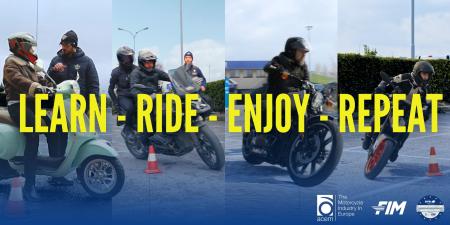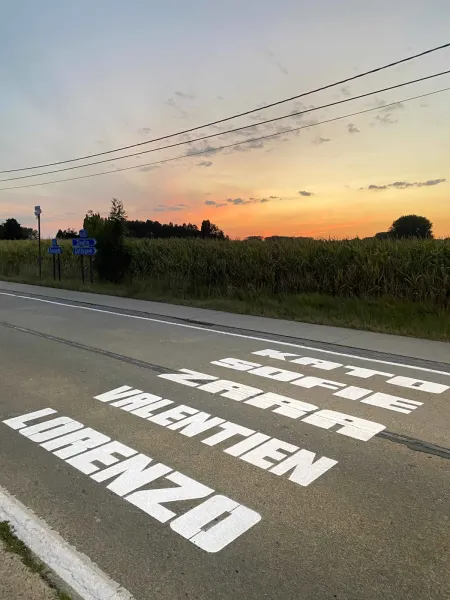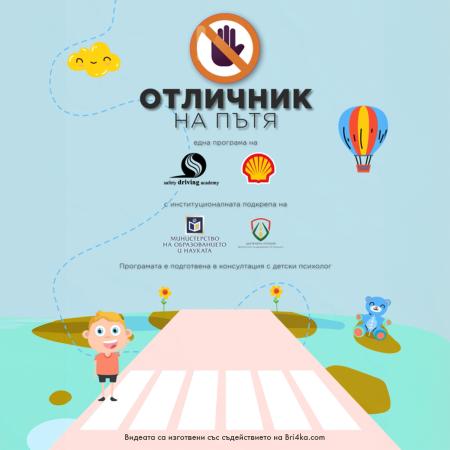Our members are dedicated to improving road safety and sharing their knowledge with the wider community. Here, you can explore our members' good practices – initiatives that have been assessed for their effectiveness in addressing a road safety problem and have proven results.
Get inspired – and sign up to share your good practices too!

Monday, June 30, 2025
The human factor has repeatedly been shown to be the most critical factor in accidents involving riders. For this reason, lifelong training should be encouraged, reaching out to new and existing motorcyclists. High-quality training is instrumental in achieving the EU safety targets on the way to Vision Zero. To ensure that society fully benefits from all the advantages offered by motorcycles, more work is necessary to further improve the safety record of riders across Europe.

Friday, May 2, 2025
Veilig Over is een initiatief dat ernaar streeft voetgangers veilig te laten oversteken en dat bovendien iedereen toestaat om ook zélf aan te duiden waar er nood is aan een veilige oversteekplaats, via een onlineplatform veiligover.be. Samen oversteken veilig maken, dat is de ambitie van ‘Veilig Over’. Dit doen we met een unieke samenwerking met lokale en regionale overheden & burgerparticipatie en citizen sciene & wetenschappelijke evaluatie (met Vias institute). Dit alles met als resultaat: de concrete verwezenlijking van een veilige oversteekplaats op het terrein!

Friday, May 2, 2025
България от години води статистиката на ЕС по брой инциденти и загинали на пътя. Сред основните причини за тази статистика, наред с други, са и поведенческите модели на участниците в движението, които са фокус на Shell България с настоящия проект. Чрез своята образователна инициатива „Отличник на пътя“ компанията адресира този проблем и дава своя принос за промяна в мисленето и културата на безопасността на пътя. Инициативата е насочена към ученици в 1. и 2. клас и има за цел да затвърди техните знания и умения, свързани с пътната безопасност, да въздейства върху тяхното поведение и да ги превърне в коректив на поведението на пътя на техните родители и близки. Доброволците от компанията целят да превърнат децата в „посланици“ на пътната безопасност и чрез тях да достигнат и до родителите им. В основата на проекта е вярването на екипа на Shell България, че и най-малката промяна си заслужава, защото тя ще доведе до спасяване на човешки живот на пътя.
Изборът на този социално-инвестиционен проект е свързан с бизнеса на Shell, който подпомага мобилността и транспорта на стоки и услуги. Целта на компанията е осигуряване на безопасно придвижване по пътищата - на служителите, на нейните бизнес партньори и клиенти и на обществото като цяло и свеждане до нула на броя на инцидентите и пострадалите на пътя.
Изборът на този социално-инвестиционен проект е свързан с бизнеса на Shell, който подпомага мобилността и транспорта на стоки и услуги. Целта на компанията е осигуряване на безопасно придвижване по пътищата - на служителите, на нейните бизнес партньори и клиенти и на обществото като цяло и свеждане до нула на броя на инцидентите и пострадалите на пътя.

Thursday, May 1, 2025
Le principali sfide in materia di sicurezza stradale che ci troviamo ad affrontare, e alle quali DUOBBRAK intende fornire una risposta concreta, sono i tassi costantemente elevati di incidenti e decessi evitabili a livello globale, esacerbati dai limiti intrinseci e dai potenziali guasti degli attuali sistemi di frenatura.
I frequenti richiami di veicoli dovuti a problemi ai freni, che colpiscono milioni di persone all'anno (si stima che i problemi ai freni contribuiscono a una percentuale significativa di incidenti con guasti meccanici), sottolineano questa fragilità e le conseguenze economiche per i produttori e la fiducia dei consumatori.
La miopia del settore nell'abbracciare innovazioni puramente meccaniche, come dimostrato dalla tiepida accoglienza iniziale di DUOBBRAK, ha contribuito a perpetuare queste vulnerabilità.
Inoltre, la dipendenza dell'industria automobilistica da materiali rari e ad alto impatto ambientale per le tecnologie di frenata crea instabilità economica e preoccupazioni geopolitiche.
Esiste una lacuna critica nella ricerca e nell'adozione di una soluzione universalmente affidabile, puramente meccanica, che migliora significativamente le prestazioni di frenata e garantisce la sicurezza anche in caso di guasto del sistema.
Questa inerzia non solo compromette la sicurezza stradale, ma ha anche implicazioni per la competitività e la sostenibilità del settore automobilistico storico occidentale.
I frequenti richiami di veicoli dovuti a problemi ai freni, che colpiscono milioni di persone all'anno (si stima che i problemi ai freni contribuiscono a una percentuale significativa di incidenti con guasti meccanici), sottolineano questa fragilità e le conseguenze economiche per i produttori e la fiducia dei consumatori.
La miopia del settore nell'abbracciare innovazioni puramente meccaniche, come dimostrato dalla tiepida accoglienza iniziale di DUOBBRAK, ha contribuito a perpetuare queste vulnerabilità.
Inoltre, la dipendenza dell'industria automobilistica da materiali rari e ad alto impatto ambientale per le tecnologie di frenata crea instabilità economica e preoccupazioni geopolitiche.
Esiste una lacuna critica nella ricerca e nell'adozione di una soluzione universalmente affidabile, puramente meccanica, che migliora significativamente le prestazioni di frenata e garantisce la sicurezza anche in caso di guasto del sistema.
Questa inerzia non solo compromette la sicurezza stradale, ma ha anche implicazioni per la competitività e la sostenibilità del settore automobilistico storico occidentale.

Thursday, April 24, 2025
Due to the necessities of the road network, generally road works occur whilst roads are still open for use by all classes of road users. Hence it is important that the pedestrian, vehicular and cycling traffic is designed and managed to reduce the safety risks of users.
Research has shown that the risk of a serious traffic collision at or in a road works site is three to five times more than on other parts of the road network (CAREC, 2018).
The implementation and maintenance of the road safety measures at work sites is important but it is equally important that all road users understand and appreciate the safety risks and the operational aspects of such work sites.
We have identified the need for specific Road Safety Awareness Education and Training with FOCUS ON WORK SITES. This aspect is commonly omitted from general Road Safety Education Programmes. Road users, namely passengers, drivers, cyclists and pedestrians across different age groups are addressed.
Research has shown that the risk of a serious traffic collision at or in a road works site is three to five times more than on other parts of the road network (CAREC, 2018).
The implementation and maintenance of the road safety measures at work sites is important but it is equally important that all road users understand and appreciate the safety risks and the operational aspects of such work sites.
We have identified the need for specific Road Safety Awareness Education and Training with FOCUS ON WORK SITES. This aspect is commonly omitted from general Road Safety Education Programmes. Road users, namely passengers, drivers, cyclists and pedestrians across different age groups are addressed.